BUSN304: Conflict Management, Self Identity, and Personality Study
VerifiedAdded on 2022/09/14
|7
|1947
|10
Essay
AI Summary
This essay explores the critical relationship between self-identity and conflict management, drawing upon personal experiences and established theories. The author delves into the significance of self-identity, attitude, personality, and behavior in navigating social interactions and resolving conflicts. The essay employs reflective writing and incorporates tools such as the Johari Window, MBTI, and DISC personality tests to analyze the author's own self-identity and personality traits. It provides examples of conflict situations and how the author utilized their self-awareness to mediate and resolve conflicts, demonstrating the practical application of the concepts discussed. The essay highlights the importance of understanding one's own characteristics and how they influence interactions and conflict resolution, offering valuable insights into effective conflict management strategies.
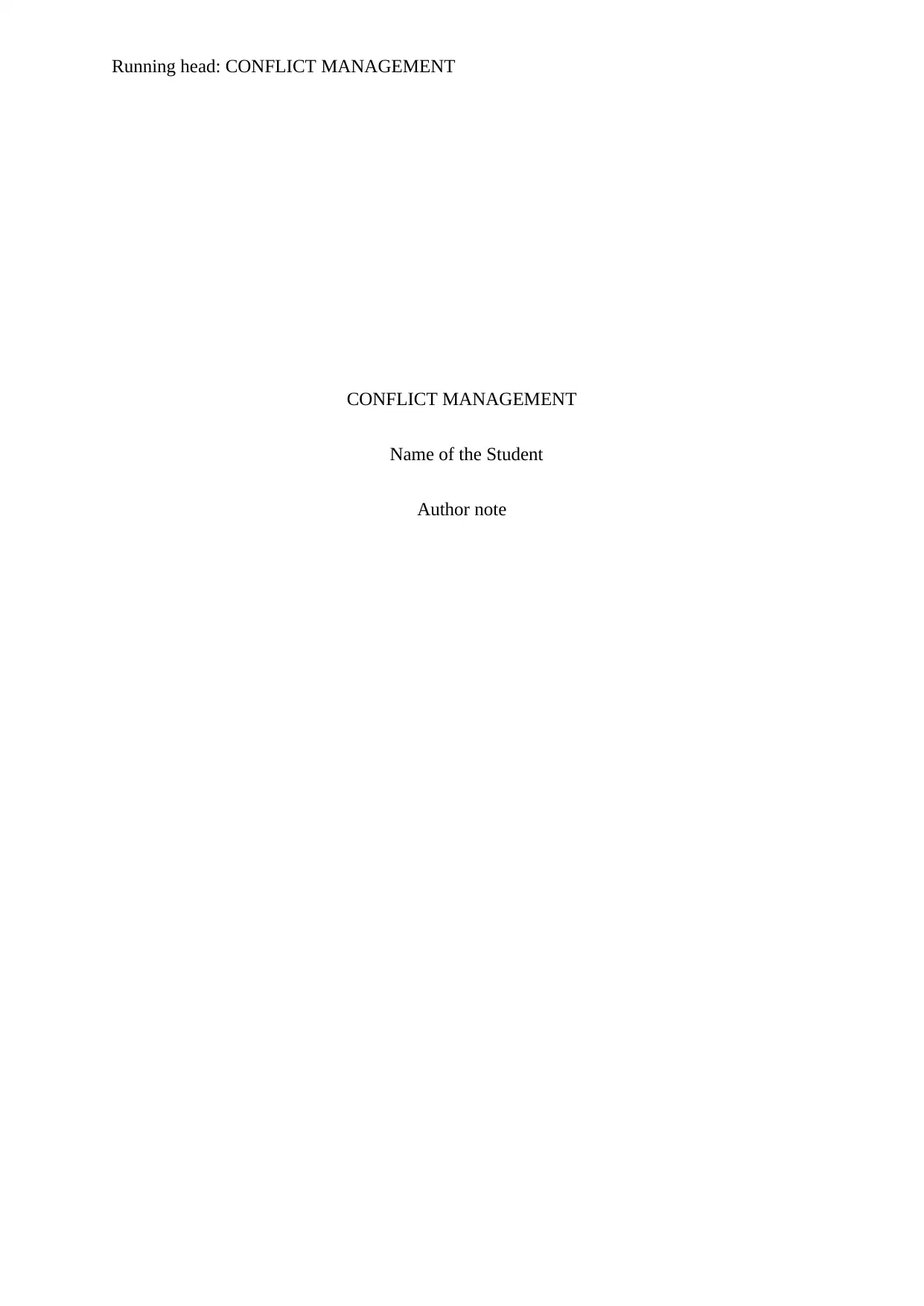
Running head: CONFLICT MANAGEMENT
CONFLICT MANAGEMENT
Name of the Student
Author note
CONFLICT MANAGEMENT
Name of the Student
Author note
Paraphrase This Document
Need a fresh take? Get an instant paraphrase of this document with our AI Paraphraser
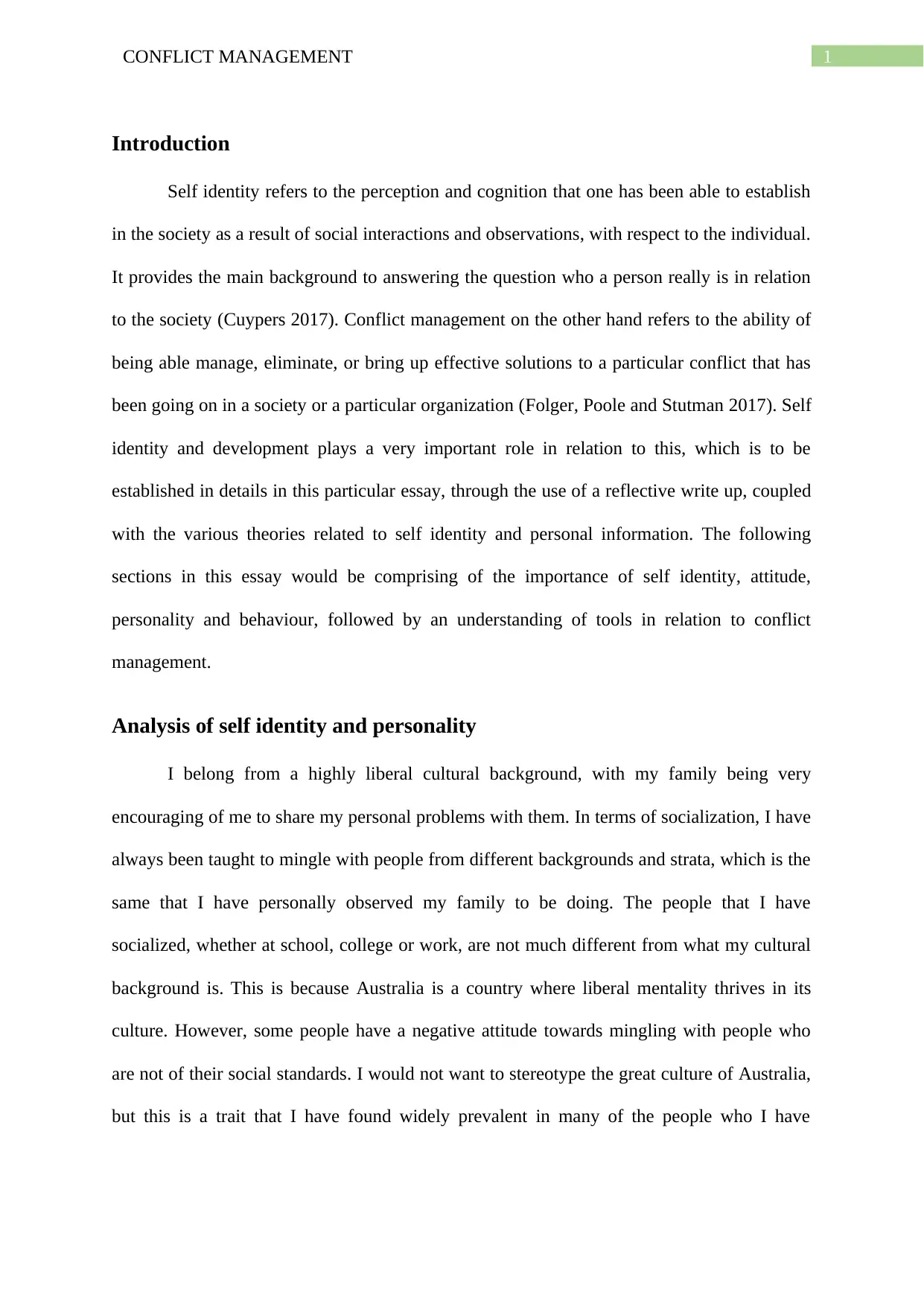
1CONFLICT MANAGEMENT
Introduction
Self identity refers to the perception and cognition that one has been able to establish
in the society as a result of social interactions and observations, with respect to the individual.
It provides the main background to answering the question who a person really is in relation
to the society (Cuypers 2017). Conflict management on the other hand refers to the ability of
being able manage, eliminate, or bring up effective solutions to a particular conflict that has
been going on in a society or a particular organization (Folger, Poole and Stutman 2017). Self
identity and development plays a very important role in relation to this, which is to be
established in details in this particular essay, through the use of a reflective write up, coupled
with the various theories related to self identity and personal information. The following
sections in this essay would be comprising of the importance of self identity, attitude,
personality and behaviour, followed by an understanding of tools in relation to conflict
management.
Analysis of self identity and personality
I belong from a highly liberal cultural background, with my family being very
encouraging of me to share my personal problems with them. In terms of socialization, I have
always been taught to mingle with people from different backgrounds and strata, which is the
same that I have personally observed my family to be doing. The people that I have
socialized, whether at school, college or work, are not much different from what my cultural
background is. This is because Australia is a country where liberal mentality thrives in its
culture. However, some people have a negative attitude towards mingling with people who
are not of their social standards. I would not want to stereotype the great culture of Australia,
but this is a trait that I have found widely prevalent in many of the people who I have
Introduction
Self identity refers to the perception and cognition that one has been able to establish
in the society as a result of social interactions and observations, with respect to the individual.
It provides the main background to answering the question who a person really is in relation
to the society (Cuypers 2017). Conflict management on the other hand refers to the ability of
being able manage, eliminate, or bring up effective solutions to a particular conflict that has
been going on in a society or a particular organization (Folger, Poole and Stutman 2017). Self
identity and development plays a very important role in relation to this, which is to be
established in details in this particular essay, through the use of a reflective write up, coupled
with the various theories related to self identity and personal information. The following
sections in this essay would be comprising of the importance of self identity, attitude,
personality and behaviour, followed by an understanding of tools in relation to conflict
management.
Analysis of self identity and personality
I belong from a highly liberal cultural background, with my family being very
encouraging of me to share my personal problems with them. In terms of socialization, I have
always been taught to mingle with people from different backgrounds and strata, which is the
same that I have personally observed my family to be doing. The people that I have
socialized, whether at school, college or work, are not much different from what my cultural
background is. This is because Australia is a country where liberal mentality thrives in its
culture. However, some people have a negative attitude towards mingling with people who
are not of their social standards. I would not want to stereotype the great culture of Australia,
but this is a trait that I have found widely prevalent in many of the people who I have
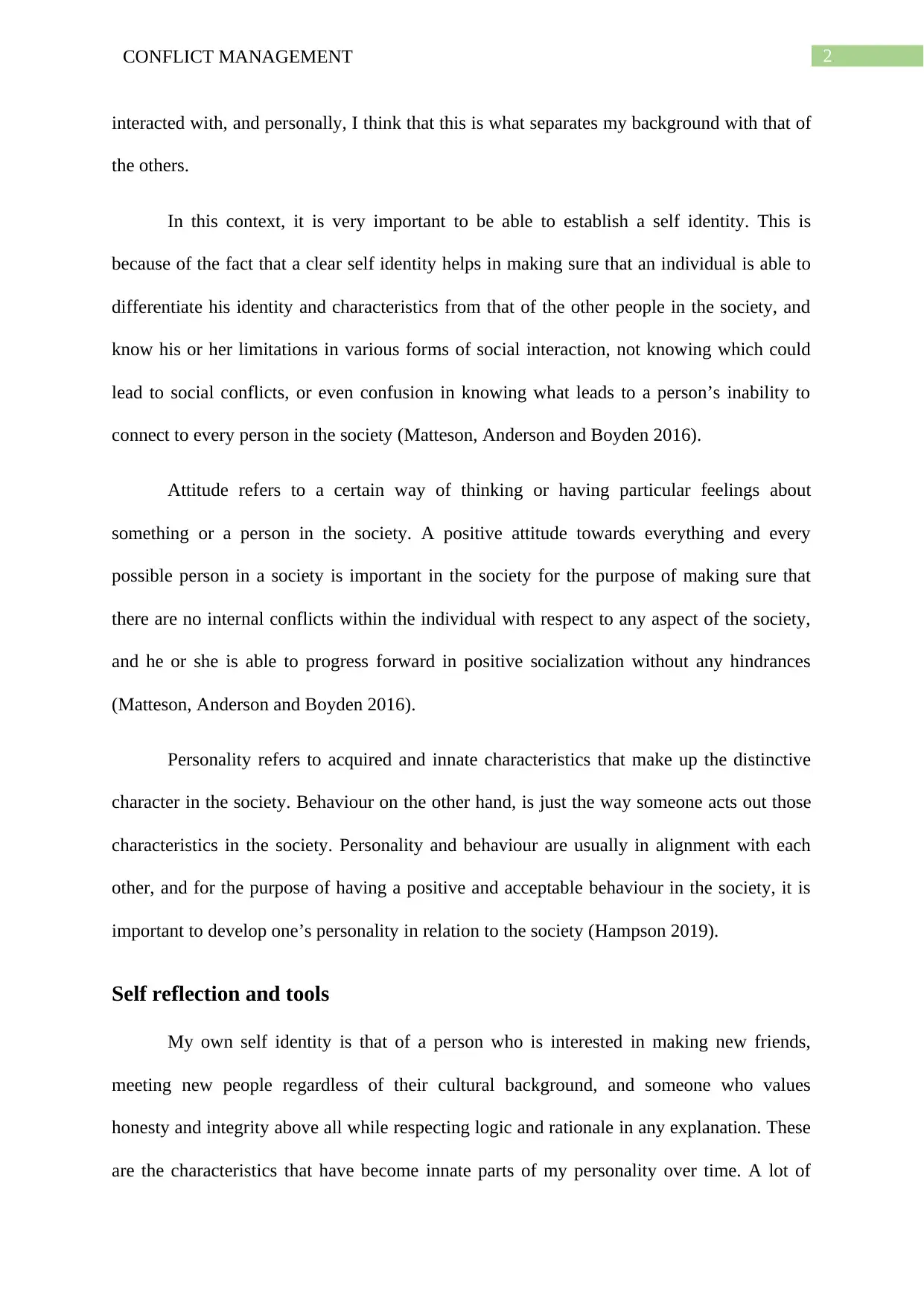
2CONFLICT MANAGEMENT
interacted with, and personally, I think that this is what separates my background with that of
the others.
In this context, it is very important to be able to establish a self identity. This is
because of the fact that a clear self identity helps in making sure that an individual is able to
differentiate his identity and characteristics from that of the other people in the society, and
know his or her limitations in various forms of social interaction, not knowing which could
lead to social conflicts, or even confusion in knowing what leads to a person’s inability to
connect to every person in the society (Matteson, Anderson and Boyden 2016).
Attitude refers to a certain way of thinking or having particular feelings about
something or a person in the society. A positive attitude towards everything and every
possible person in a society is important in the society for the purpose of making sure that
there are no internal conflicts within the individual with respect to any aspect of the society,
and he or she is able to progress forward in positive socialization without any hindrances
(Matteson, Anderson and Boyden 2016).
Personality refers to acquired and innate characteristics that make up the distinctive
character in the society. Behaviour on the other hand, is just the way someone acts out those
characteristics in the society. Personality and behaviour are usually in alignment with each
other, and for the purpose of having a positive and acceptable behaviour in the society, it is
important to develop one’s personality in relation to the society (Hampson 2019).
Self reflection and tools
My own self identity is that of a person who is interested in making new friends,
meeting new people regardless of their cultural background, and someone who values
honesty and integrity above all while respecting logic and rationale in any explanation. These
are the characteristics that have become innate parts of my personality over time. A lot of
interacted with, and personally, I think that this is what separates my background with that of
the others.
In this context, it is very important to be able to establish a self identity. This is
because of the fact that a clear self identity helps in making sure that an individual is able to
differentiate his identity and characteristics from that of the other people in the society, and
know his or her limitations in various forms of social interaction, not knowing which could
lead to social conflicts, or even confusion in knowing what leads to a person’s inability to
connect to every person in the society (Matteson, Anderson and Boyden 2016).
Attitude refers to a certain way of thinking or having particular feelings about
something or a person in the society. A positive attitude towards everything and every
possible person in a society is important in the society for the purpose of making sure that
there are no internal conflicts within the individual with respect to any aspect of the society,
and he or she is able to progress forward in positive socialization without any hindrances
(Matteson, Anderson and Boyden 2016).
Personality refers to acquired and innate characteristics that make up the distinctive
character in the society. Behaviour on the other hand, is just the way someone acts out those
characteristics in the society. Personality and behaviour are usually in alignment with each
other, and for the purpose of having a positive and acceptable behaviour in the society, it is
important to develop one’s personality in relation to the society (Hampson 2019).
Self reflection and tools
My own self identity is that of a person who is interested in making new friends,
meeting new people regardless of their cultural background, and someone who values
honesty and integrity above all while respecting logic and rationale in any explanation. These
are the characteristics that have become innate parts of my personality over time. A lot of
⊘ This is a preview!⊘
Do you want full access?
Subscribe today to unlock all pages.

Trusted by 1+ million students worldwide
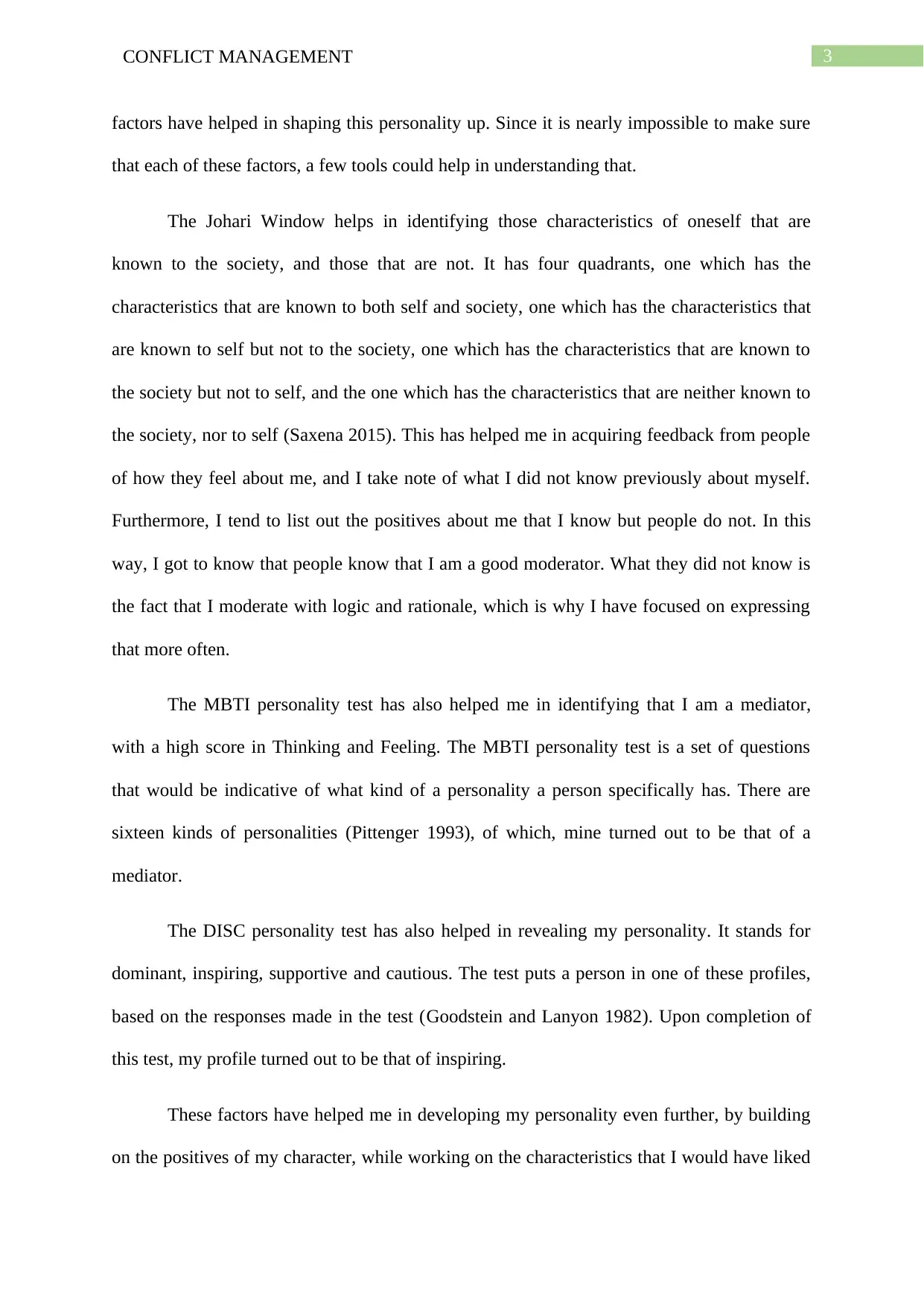
3CONFLICT MANAGEMENT
factors have helped in shaping this personality up. Since it is nearly impossible to make sure
that each of these factors, a few tools could help in understanding that.
The Johari Window helps in identifying those characteristics of oneself that are
known to the society, and those that are not. It has four quadrants, one which has the
characteristics that are known to both self and society, one which has the characteristics that
are known to self but not to the society, one which has the characteristics that are known to
the society but not to self, and the one which has the characteristics that are neither known to
the society, nor to self (Saxena 2015). This has helped me in acquiring feedback from people
of how they feel about me, and I take note of what I did not know previously about myself.
Furthermore, I tend to list out the positives about me that I know but people do not. In this
way, I got to know that people know that I am a good moderator. What they did not know is
the fact that I moderate with logic and rationale, which is why I have focused on expressing
that more often.
The MBTI personality test has also helped me in identifying that I am a mediator,
with a high score in Thinking and Feeling. The MBTI personality test is a set of questions
that would be indicative of what kind of a personality a person specifically has. There are
sixteen kinds of personalities (Pittenger 1993), of which, mine turned out to be that of a
mediator.
The DISC personality test has also helped in revealing my personality. It stands for
dominant, inspiring, supportive and cautious. The test puts a person in one of these profiles,
based on the responses made in the test (Goodstein and Lanyon 1982). Upon completion of
this test, my profile turned out to be that of inspiring.
These factors have helped me in developing my personality even further, by building
on the positives of my character, while working on the characteristics that I would have liked
factors have helped in shaping this personality up. Since it is nearly impossible to make sure
that each of these factors, a few tools could help in understanding that.
The Johari Window helps in identifying those characteristics of oneself that are
known to the society, and those that are not. It has four quadrants, one which has the
characteristics that are known to both self and society, one which has the characteristics that
are known to self but not to the society, one which has the characteristics that are known to
the society but not to self, and the one which has the characteristics that are neither known to
the society, nor to self (Saxena 2015). This has helped me in acquiring feedback from people
of how they feel about me, and I take note of what I did not know previously about myself.
Furthermore, I tend to list out the positives about me that I know but people do not. In this
way, I got to know that people know that I am a good moderator. What they did not know is
the fact that I moderate with logic and rationale, which is why I have focused on expressing
that more often.
The MBTI personality test has also helped me in identifying that I am a mediator,
with a high score in Thinking and Feeling. The MBTI personality test is a set of questions
that would be indicative of what kind of a personality a person specifically has. There are
sixteen kinds of personalities (Pittenger 1993), of which, mine turned out to be that of a
mediator.
The DISC personality test has also helped in revealing my personality. It stands for
dominant, inspiring, supportive and cautious. The test puts a person in one of these profiles,
based on the responses made in the test (Goodstein and Lanyon 1982). Upon completion of
this test, my profile turned out to be that of inspiring.
These factors have helped me in developing my personality even further, by building
on the positives of my character, while working on the characteristics that I would have liked
Paraphrase This Document
Need a fresh take? Get an instant paraphrase of this document with our AI Paraphraser
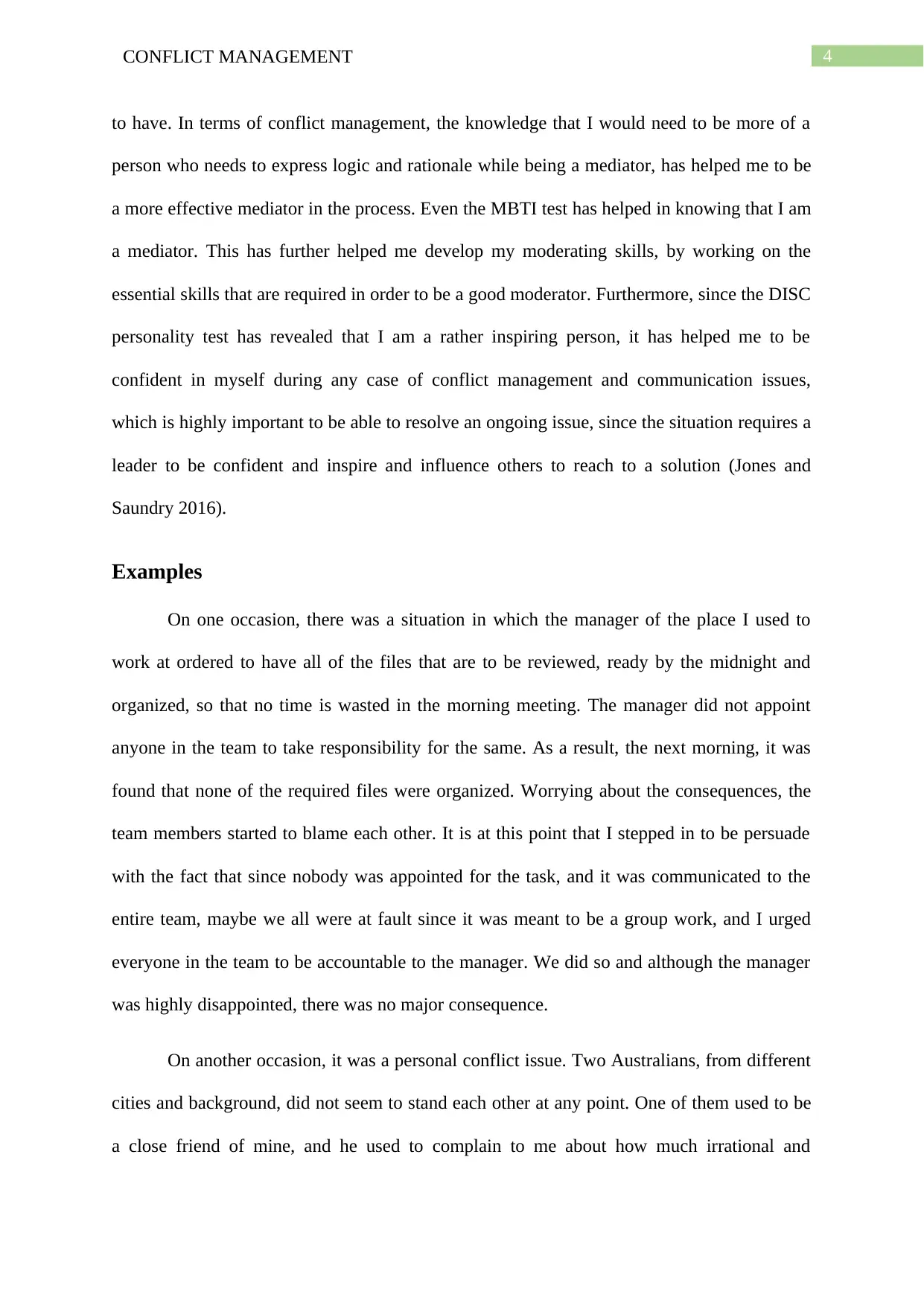
4CONFLICT MANAGEMENT
to have. In terms of conflict management, the knowledge that I would need to be more of a
person who needs to express logic and rationale while being a mediator, has helped me to be
a more effective mediator in the process. Even the MBTI test has helped in knowing that I am
a mediator. This has further helped me develop my moderating skills, by working on the
essential skills that are required in order to be a good moderator. Furthermore, since the DISC
personality test has revealed that I am a rather inspiring person, it has helped me to be
confident in myself during any case of conflict management and communication issues,
which is highly important to be able to resolve an ongoing issue, since the situation requires a
leader to be confident and inspire and influence others to reach to a solution (Jones and
Saundry 2016).
Examples
On one occasion, there was a situation in which the manager of the place I used to
work at ordered to have all of the files that are to be reviewed, ready by the midnight and
organized, so that no time is wasted in the morning meeting. The manager did not appoint
anyone in the team to take responsibility for the same. As a result, the next morning, it was
found that none of the required files were organized. Worrying about the consequences, the
team members started to blame each other. It is at this point that I stepped in to be persuade
with the fact that since nobody was appointed for the task, and it was communicated to the
entire team, maybe we all were at fault since it was meant to be a group work, and I urged
everyone in the team to be accountable to the manager. We did so and although the manager
was highly disappointed, there was no major consequence.
On another occasion, it was a personal conflict issue. Two Australians, from different
cities and background, did not seem to stand each other at any point. One of them used to be
a close friend of mine, and he used to complain to me about how much irrational and
to have. In terms of conflict management, the knowledge that I would need to be more of a
person who needs to express logic and rationale while being a mediator, has helped me to be
a more effective mediator in the process. Even the MBTI test has helped in knowing that I am
a mediator. This has further helped me develop my moderating skills, by working on the
essential skills that are required in order to be a good moderator. Furthermore, since the DISC
personality test has revealed that I am a rather inspiring person, it has helped me to be
confident in myself during any case of conflict management and communication issues,
which is highly important to be able to resolve an ongoing issue, since the situation requires a
leader to be confident and inspire and influence others to reach to a solution (Jones and
Saundry 2016).
Examples
On one occasion, there was a situation in which the manager of the place I used to
work at ordered to have all of the files that are to be reviewed, ready by the midnight and
organized, so that no time is wasted in the morning meeting. The manager did not appoint
anyone in the team to take responsibility for the same. As a result, the next morning, it was
found that none of the required files were organized. Worrying about the consequences, the
team members started to blame each other. It is at this point that I stepped in to be persuade
with the fact that since nobody was appointed for the task, and it was communicated to the
entire team, maybe we all were at fault since it was meant to be a group work, and I urged
everyone in the team to be accountable to the manager. We did so and although the manager
was highly disappointed, there was no major consequence.
On another occasion, it was a personal conflict issue. Two Australians, from different
cities and background, did not seem to stand each other at any point. One of them used to be
a close friend of mine, and he used to complain to me about how much irrational and
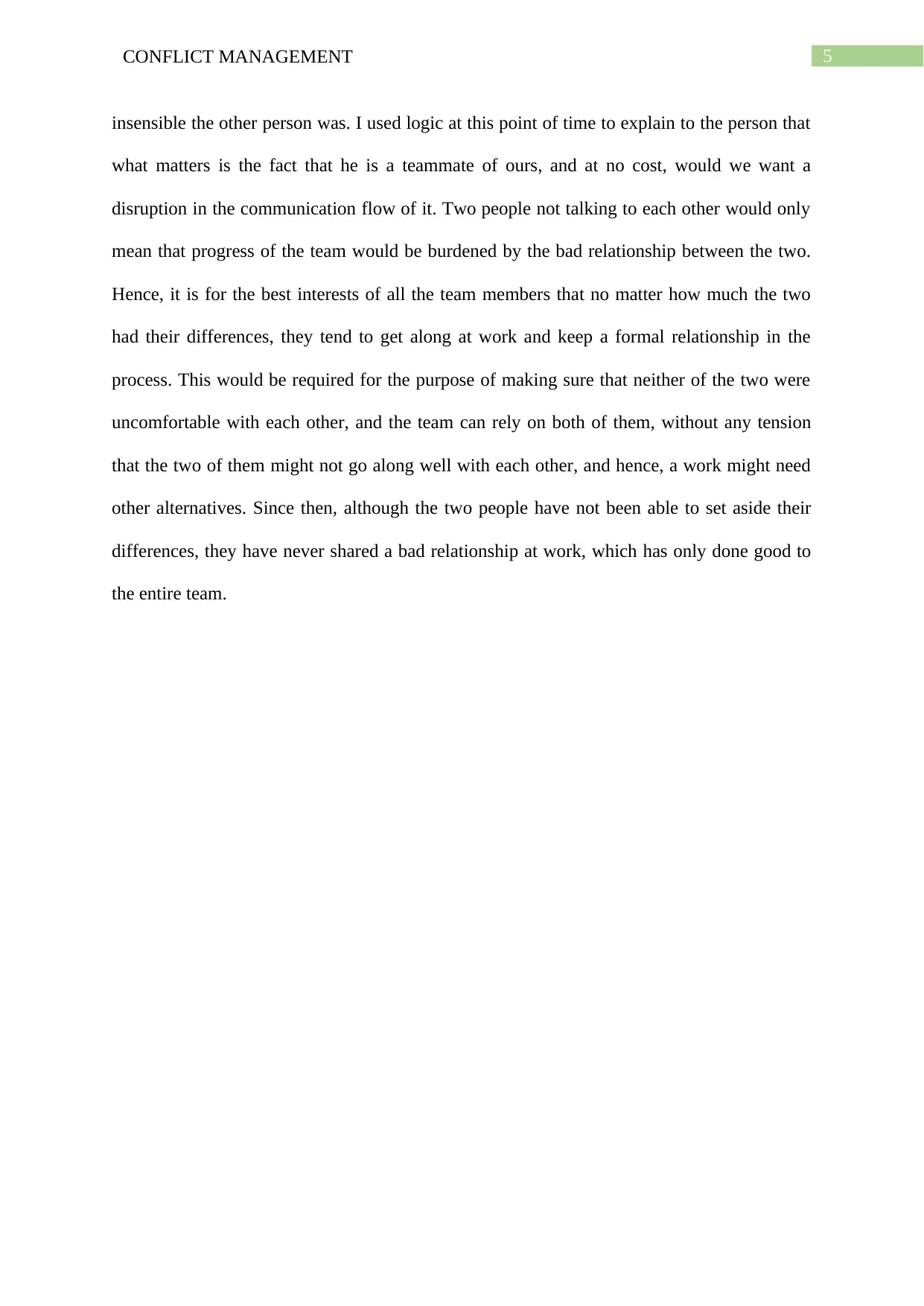
5CONFLICT MANAGEMENT
insensible the other person was. I used logic at this point of time to explain to the person that
what matters is the fact that he is a teammate of ours, and at no cost, would we want a
disruption in the communication flow of it. Two people not talking to each other would only
mean that progress of the team would be burdened by the bad relationship between the two.
Hence, it is for the best interests of all the team members that no matter how much the two
had their differences, they tend to get along at work and keep a formal relationship in the
process. This would be required for the purpose of making sure that neither of the two were
uncomfortable with each other, and the team can rely on both of them, without any tension
that the two of them might not go along well with each other, and hence, a work might need
other alternatives. Since then, although the two people have not been able to set aside their
differences, they have never shared a bad relationship at work, which has only done good to
the entire team.
insensible the other person was. I used logic at this point of time to explain to the person that
what matters is the fact that he is a teammate of ours, and at no cost, would we want a
disruption in the communication flow of it. Two people not talking to each other would only
mean that progress of the team would be burdened by the bad relationship between the two.
Hence, it is for the best interests of all the team members that no matter how much the two
had their differences, they tend to get along at work and keep a formal relationship in the
process. This would be required for the purpose of making sure that neither of the two were
uncomfortable with each other, and the team can rely on both of them, without any tension
that the two of them might not go along well with each other, and hence, a work might need
other alternatives. Since then, although the two people have not been able to set aside their
differences, they have never shared a bad relationship at work, which has only done good to
the entire team.
⊘ This is a preview!⊘
Do you want full access?
Subscribe today to unlock all pages.

Trusted by 1+ million students worldwide
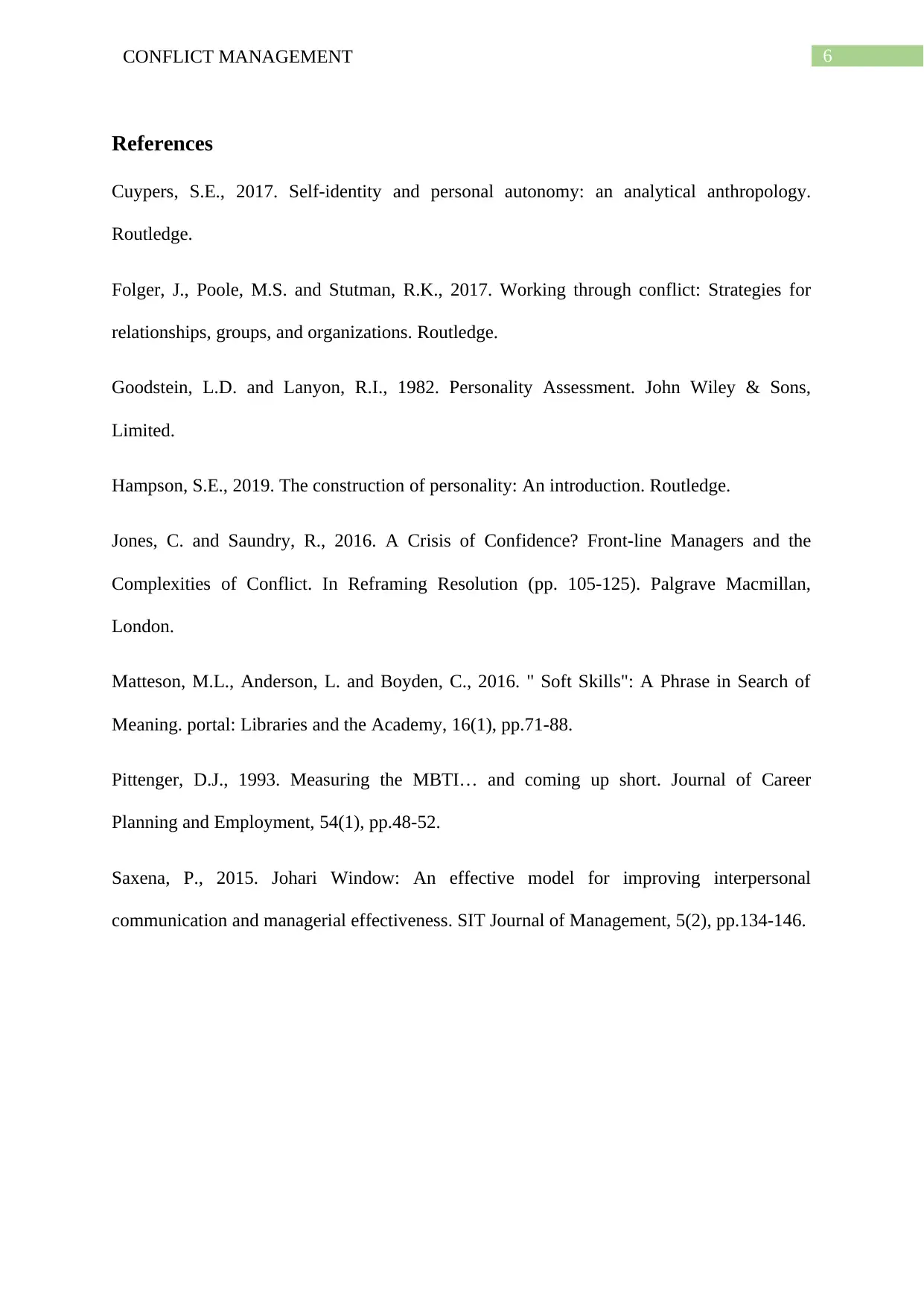
6CONFLICT MANAGEMENT
References
Cuypers, S.E., 2017. Self-identity and personal autonomy: an analytical anthropology.
Routledge.
Folger, J., Poole, M.S. and Stutman, R.K., 2017. Working through conflict: Strategies for
relationships, groups, and organizations. Routledge.
Goodstein, L.D. and Lanyon, R.I., 1982. Personality Assessment. John Wiley & Sons,
Limited.
Hampson, S.E., 2019. The construction of personality: An introduction. Routledge.
Jones, C. and Saundry, R., 2016. A Crisis of Confidence? Front-line Managers and the
Complexities of Conflict. In Reframing Resolution (pp. 105-125). Palgrave Macmillan,
London.
Matteson, M.L., Anderson, L. and Boyden, C., 2016. " Soft Skills": A Phrase in Search of
Meaning. portal: Libraries and the Academy, 16(1), pp.71-88.
Pittenger, D.J., 1993. Measuring the MBTI… and coming up short. Journal of Career
Planning and Employment, 54(1), pp.48-52.
Saxena, P., 2015. Johari Window: An effective model for improving interpersonal
communication and managerial effectiveness. SIT Journal of Management, 5(2), pp.134-146.
References
Cuypers, S.E., 2017. Self-identity and personal autonomy: an analytical anthropology.
Routledge.
Folger, J., Poole, M.S. and Stutman, R.K., 2017. Working through conflict: Strategies for
relationships, groups, and organizations. Routledge.
Goodstein, L.D. and Lanyon, R.I., 1982. Personality Assessment. John Wiley & Sons,
Limited.
Hampson, S.E., 2019. The construction of personality: An introduction. Routledge.
Jones, C. and Saundry, R., 2016. A Crisis of Confidence? Front-line Managers and the
Complexities of Conflict. In Reframing Resolution (pp. 105-125). Palgrave Macmillan,
London.
Matteson, M.L., Anderson, L. and Boyden, C., 2016. " Soft Skills": A Phrase in Search of
Meaning. portal: Libraries and the Academy, 16(1), pp.71-88.
Pittenger, D.J., 1993. Measuring the MBTI… and coming up short. Journal of Career
Planning and Employment, 54(1), pp.48-52.
Saxena, P., 2015. Johari Window: An effective model for improving interpersonal
communication and managerial effectiveness. SIT Journal of Management, 5(2), pp.134-146.
1 out of 7
Related Documents
Your All-in-One AI-Powered Toolkit for Academic Success.
+13062052269
info@desklib.com
Available 24*7 on WhatsApp / Email
![[object Object]](/_next/static/media/star-bottom.7253800d.svg)
Unlock your academic potential
Copyright © 2020–2025 A2Z Services. All Rights Reserved. Developed and managed by ZUCOL.




